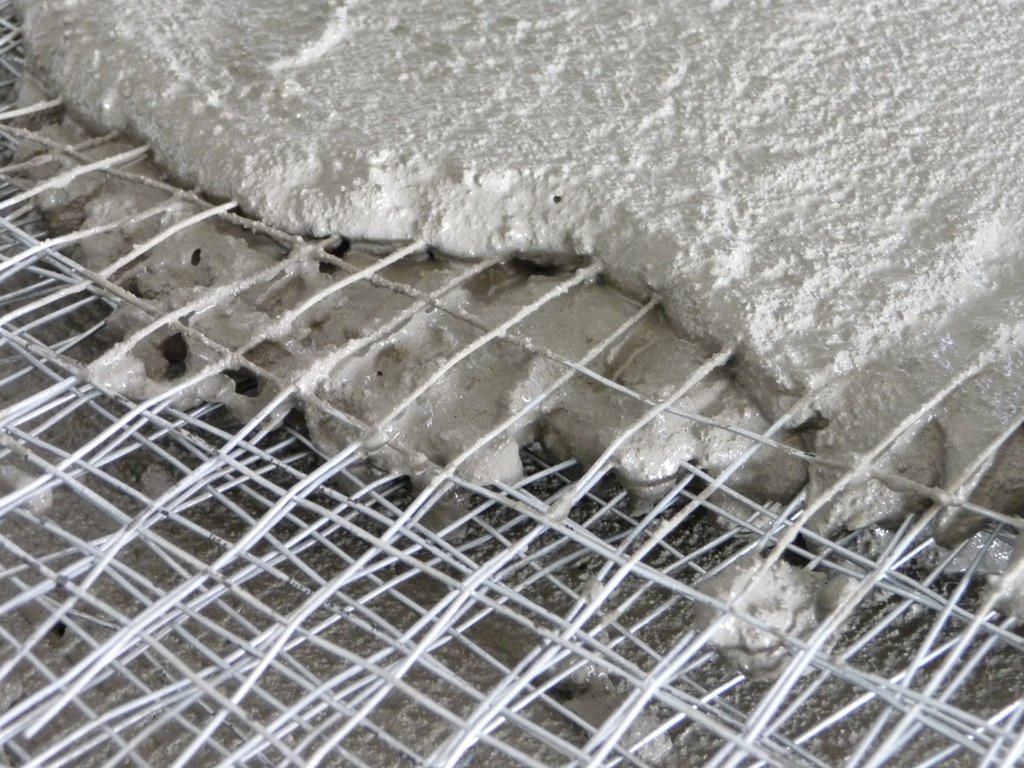Ferro-cement
Ferro-cement is a composite material made up of mortar and light wire steel mesh. It is a highly versatile form of reinforced concrete.
The mesh is formed into the shape of the structure in thin sections, and should mesh uniformly throughout the cross-section. Rebar is sometimes used as a means of stiffening the structure. On both sides of the reinforcement layer the stiff mortar is applied to the required thickness. Care must be taken to completely cover with metal with mortar, or else the metal may be at risk of corrosion.
The strength of the ferro-cement is determined by the quality of the sand/cement mortar mix and the quantity of the reinforcing materials used.
Ferro-cement is typically used to relatively thin but strong surfaces and structures, such as for shell roofs, water tanks, and so on.
Due to the increased amount of labour required for the construction process, ferro-cement structures tend to be found in countries with low labour costs, such as in Asia and the Pacific regions.
The advantages of ferro-cement are as follows:
- It can be fabricated into any shape required.
- Construction is relatively easy and low-skill.
- It is a lightweight material with good durability.
- Relatively cost-effective.
The disadvantages of ferro-cement are as follows:
- Fastening with bolts, screws, nails, and such like, can be difficult on ferro-cement.
- Labour-intensive construction process.
- Tying rods and mesh together is time-consuming.
- Can be vulnerable to puncture from pointed objects.
[edit] Related articles on Designing Buildings Wiki
Featured articles and news
Latest Build UK Building Safety Regime explainer published
Key elements in one short, now updated document.
UKGBC launch the UK Climate Resilience Roadmap
First guidance of its kind on direct climate impacts for the built environment and how it can adapt.
CLC Health, Safety and Wellbeing Strategy 2025
Launched by the Minister for Industry to look at fatalities on site, improving mental health and other issues.
One of the most impressive Victorian architects. Book review.
Common Assessment Standard now with building safety
New CAS update now includes mandatory building safety questions.
RTPI leader to become new CIOB Chief Executive Officer
Dr Victoria Hills MRTPI, FICE to take over after Caroline Gumble’s departure.
Social and affordable housing, a long term plan for delivery
The “Delivering a Decade of Renewal for Social and Affordable Housing” strategy sets out future path.
A change to adoptive architecture
Effects of global weather warming on architectural detailing, material choice and human interaction.
The proposed publicly owned and backed subsidiary of Homes England, to facilitate new homes.
How big is the problem and what can we do to mitigate the effects?
Overheating guidance and tools for building designers
A number of cool guides to help with the heat.
The UK's Modern Industrial Strategy: A 10 year plan
Previous consultation criticism, current key elements and general support with some persisting reservations.
Building Safety Regulator reforms
New roles, new staff and a new fast track service pave the way for a single construction regulator.
Architectural Technologist CPDs and Communications
CIAT CPD… and how you can do it!
Cooling centres and cool spaces
Managing extreme heat in cities by directing the public to places for heat stress relief and water sources.
Winter gardens: A brief history and warm variations
Extending the season with glass in different forms and terms.
Restoring Great Yarmouth's Winter Gardens
Transforming one of the least sustainable constructions imaginable.























